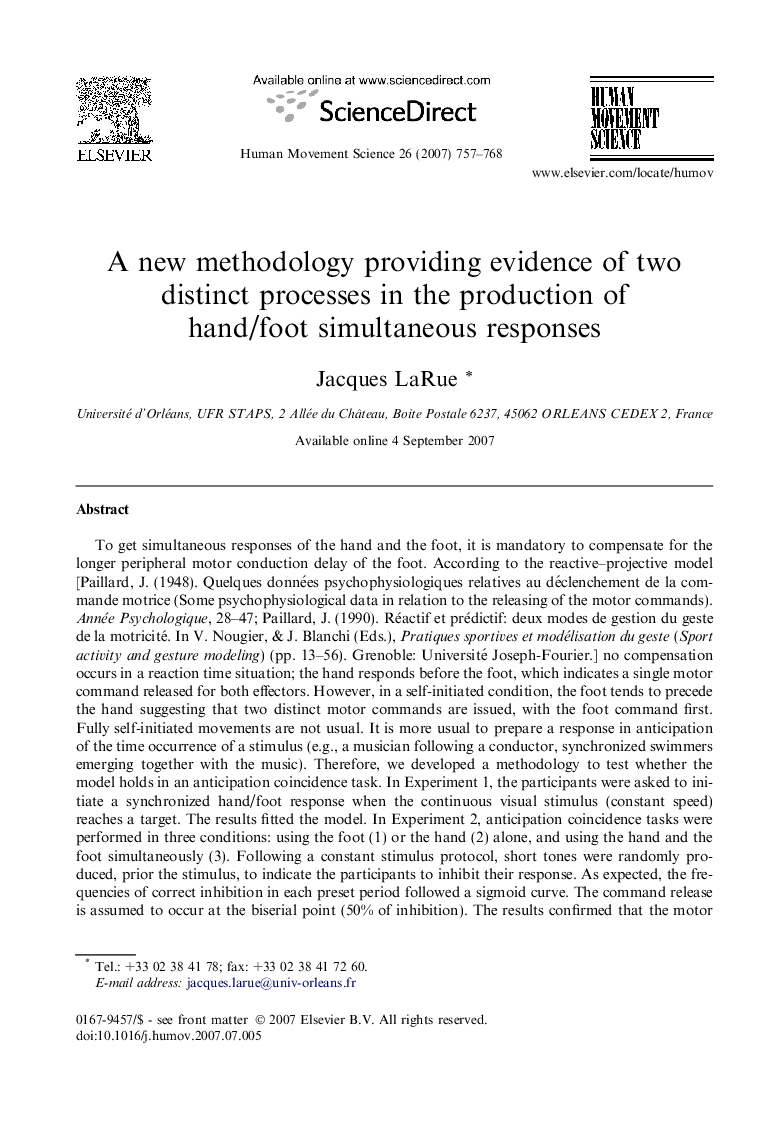| Article ID | Journal | Published Year | Pages | File Type |
|---|---|---|---|---|
| 10459284 | Human Movement Science | 2007 | 12 Pages |
Abstract
To get simultaneous responses of the hand and the foot, it is mandatory to compensate for the longer peripheral motor conduction delay of the foot. According to the reactive-projective model [Paillard, J. (1948). Quelques données psychophysiologiques relatives au déclenchement de la commande motrice (Some psychophysiological data in relation to the releasing of the motor commands). Année Psychologique, 28-47; Paillard, J. (1990). Réactif et prédictif: deux modes de gestion du geste de la motricité. In V. Nougier, & J. Blanchi (Eds.), Pratiques sportives et modélisation du geste (Sport activity and gesture modeling) (pp. 13-56). Grenoble: Université Joseph-Fourier.] no compensation occurs in a reaction time situation; the hand responds before the foot, which indicates a single motor command released for both effectors. However, in a self-initiated condition, the foot tends to precede the hand suggesting that two distinct motor commands are issued, with the foot command first. Fully self-initiated movements are not usual. It is more usual to prepare a response in anticipation of the time occurrence of a stimulus (e.g., a musician following a conductor, synchronized swimmers emerging together with the music). Therefore, we developed a methodology to test whether the model holds in an anticipation coincidence task. In Experiment 1, the participants were asked to initiate a synchronized hand/foot response when the continuous visual stimulus (constant speed) reaches a target. The results fitted the model. In Experiment 2, anticipation coincidence tasks were performed in three conditions: using the foot (1) or the hand (2) alone, and using the hand and the foot simultaneously (3). Following a constant stimulus protocol, short tones were randomly produced, prior the stimulus, to indicate the participants to inhibit their response. As expected, the frequencies of correct inhibition in each preset period followed a sigmoid curve. The command release is assumed to occur at the biserial point (50% of inhibition). The results confirmed that the motor command of the foot is released sooner than the command of the hand. The hand/foot delay is lower in the simultaneous condition, because the command of the hand is released 40Â ms earlier; while the foot command is 10Â ms earlier. These data confirm and extend the projective-reactive model to a new category of coordination behavior.
Related Topics
Life Sciences
Neuroscience
Cognitive Neuroscience
Authors
Jacques LaRue,
